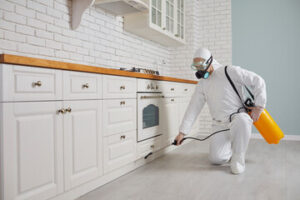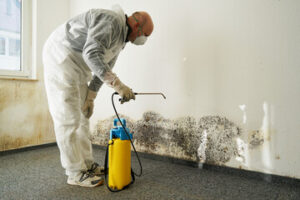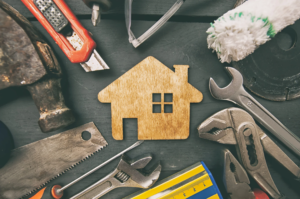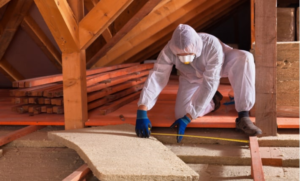Garage Door Repair OKC is a highly technical job that requires a combination of diagnostic skills, knowledge and manual dexterity. Depending on the nature of a repair, technicians must frequently work in extreme weather conditions, confined spaces, and around dangerous equipment.

A crooked or sagging garage door usually indicates a problem with the springs. These springs are responsible for lifting the door and should be replaced immediately.
It’s likely that one of your garage door’s springs is broken, which can cause the door to become unbalanced and difficult to open. The springs work closely with the cables to raise and close the door, so if one is broken the other must work harder. This can cause the cables to become worn out faster and eventually break as well.
Replacing garage door springs is not a job for the average do-it-yourself homeowner, especially when it comes to repairing torsion springs. These springs are under high tension and can cause serious injury if they’re not handled properly. This is why it’s important to always follow the manufacturer’s instructions when replacing springs.
The most obvious sign of a broken garage door spring is when the door won’t open at all. The other common sign of a broken spring is the loud bang that occurs when the spring snaps. This is because the tightly wound coils of a garage door spring contain a lot of bound energy that must release. When this happens, it will often go flying out of the garage door, hitting anything in its path including cars, walls, or storage racks.
A less obvious but still very important sign of a broken garage door spring is if you see a gap in the spring. The springs are supposed to be tightly wound and have a solid appearance, so if you see a gap, this means there is no longer any tension in the spring and it has reached its breaking point.
Once you have the new spring installed, it’s important to test the door to make sure it is working correctly. Start by attempting to raise the door. If it moves slowly or stops moving altogether, the springs are not set correctly and it’s time to adjust them.
During this process, homeowners should also take the opportunity to inspect other components of the garage door for wear or damage. If they notice any broken or rusted pieces, they should replace them now to avoid having to take the door apart again later when they need to adjust the springs. Finally, it’s a good idea to file the end of the shaft and lube the bearing if needed. This will help to keep the springs from rubbing against each other and causing further wear and tear.
Damaged Panels
When a garage door panel is damaged, it’s more than just an eyesore. Depending on the type of damage and its severity, it may be necessary to repair or replace the entire panel. While DIY repairs are tempting, this is one project that should be left to the professionals – the weight and size of your garage door is not something you want to take on without the right experience. Not to mention, if the damaged panel is structural in nature, it could affect other parts of the system that make the door function.
There are several things that can cause damage to your garage door panels. Some of the most common include normal wear and tear from regular use, weather exposure, and impacts from cars or sports equipment. Other potential issues include mold or mildew growing on the panels, cracking from impact, and warping.
The first thing you should do if you discover a damaged panel is to assess its severity. Minor dents or scratches can usually be repaired by straightening the panel. However, larger cracks or bends may require the panel to be replaced completely. Regardless of the type of damage, it’s important to address it quickly before it worsens.
If a panel is replaced, it’s important to choose the right type of material. Steel panels are durable and low-maintenance, while aluminum is lightweight and resistant to rust. Wood panels offer a classic look but require more upkeep. In addition, it’s important to consider the overall aesthetic of your home when choosing a panel for your garage door.
It’s also important to ensure the new panel is correctly measured and fitted to your garage door. If the replacement panel is not properly sized, it will cause other components to become misaligned or off track, leading to further problems down the road.
Another consideration when considering whether to repair or replace a damaged panel is the age of your garage door. If it is close to or exceeding its lifespan, replacing the entire door may be a more cost-effective option than continuing to invest in repairs.
Damaged Weather Stripping
When it comes to garage door maintenance, most issues involve moving parts, but the weather stripping around the bottom of your garage door can also wear out over time. In order to prevent cold air, rain water, pests, and other unwelcome guests from making themselves at home in your garage, it’s important to inspect the weather stripping regularly and replace it as needed.
One of the most common signs that it’s time to replace your garage door weather stripping is if you can feel a draft when you close your garage door. In addition, you may notice that your garage is much warmer or colder than usual. A professional can provide you with the necessary replacement materials and install them for you, ensuring that your garage is properly sealed and protected.
In addition to the bottom seal, your garage might also need additional or replacement weather stripping on the stop molding along the sides and top of the door, as well as a threshold seal that keeps out surface water from a driveway, especially if the floor of the garage slopes down toward the door. If you have any gaps between your garage doors, a thin piece of weather stripping can fill them and create an airtight seal that will help keep your garage clean, dry, and comfortable.
Over time, your weather stripping can become dry and brittle due to exposure to sunlight or even simply ageing. If this happens, it’s essential to have it replaced as soon as possible in order to maintain its effectiveness. A professional can offer you a selection of high-quality weatherstripping products and install them for you, ensuring a perfect fit and a good seal.
If you can’t remember the last time your garage was inspected for damaged or missing weather stripping, it’s definitely time to give us a call. Our team of professionals can ensure a seamless installation, keeping your garage safe from the elements and pests all year round. We proudly serve Nassau and Suffolk counties. Contact us today to arrange an inspection and quote.
Damaged Tracks
When the tracks are damaged, it will cause the garage door to not move properly. If you notice a gap between the door and the track, if it makes jerky movements or makes strange noises while operating, or if the tracks are misaligned, it is important to contact a professional. Delaying repairs could exacerbate the damage and increase the cost of replacement.
Replacing the garage door tracks is a complicated task, but it can be accomplished with the right guidance and tools. Start by assessing the extent of the damage and determining whether or not a full replacement is needed. If you’re replacing tracks, be sure to use a high-quality replacement set for optimal results.
It’s also important to make sure that the new tracks are securely attached and aligned. If they aren’t, this can lead to further damage to other parts of the garage door system and even pose a safety risk. Once you’ve installed the new tracks, be sure to test them by opening and closing the garage door manually and using the remote control. It’s also a good idea to test the new tracks with a car, as this will help ensure that they’re fully functional and safe.
In some cases, the tracks may only be slightly bent and can be straightened at home. To do this, you’ll need to loosen the bolts that hold the track in place and then gently tap it into a vertical position. Be careful not to apply too much force, as this can cause the tracks to break.
In most cases, the best way to repair a damaged garage door is to contact a professional for assessment and replacement. Professionals can replace the damaged track components, and ensure that the new ones are properly aligned and secured. They can also check the other parts of the garage door system, such as the hinges and rollers, to make sure they are functioning normally. Doing so will prevent other, more expensive problems from developing down the line. It will also help ensure that your garage door functions safely for a long time to come.








